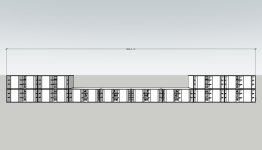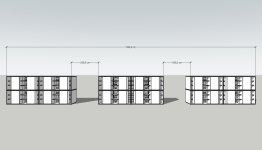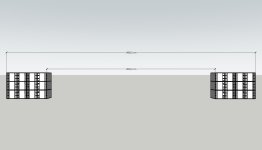I will give specific details on the project I am working on but this should apply to most others too if one adjusts accordingly.
In the example project, we will utilize B&C S218BP subwoofer enclosures with 18DS115 drivers. In the end we aim to have 12 of these enclosures. They will be crossed around 60-80hz to our midbass enclosures (they can play down to 60hz in stacks and each contain 2x15" B&C drivers). On top of the midbass we have tops.
I will calculate the mutual coupling distance from 80hz as they will still be making a lot of spl around there even when crossed at 60hz. 80hz has a wavelength of about 4.29 meters. 1/4 of it is about 1.07 meters. So, theoretically mutual coupling within working passband is possible within 1m distance.
Adhering to that, there would still be many ways to stack these. What would be the pros and cons for these different scenarios?
*Please, let's assume open-air, so no room gain etc. to effect our preference.
Here are the three different scenarios.
Scenario 1

Scenario 2

Scenario 3

In the example project, we will utilize B&C S218BP subwoofer enclosures with 18DS115 drivers. In the end we aim to have 12 of these enclosures. They will be crossed around 60-80hz to our midbass enclosures (they can play down to 60hz in stacks and each contain 2x15" B&C drivers). On top of the midbass we have tops.
I will calculate the mutual coupling distance from 80hz as they will still be making a lot of spl around there even when crossed at 60hz. 80hz has a wavelength of about 4.29 meters. 1/4 of it is about 1.07 meters. So, theoretically mutual coupling within working passband is possible within 1m distance.
Adhering to that, there would still be many ways to stack these. What would be the pros and cons for these different scenarios?
*Please, let's assume open-air, so no room gain etc. to effect our preference.
Here are the three different scenarios.
Scenario 1

Scenario 2

Scenario 3

My guess is; if we assume a correct beamforming is applied for the scenario 1 (delaying the subs progressively towards outside) that would be the best for an outdoor space. It would have to best directivity within its passband, good even coverage.
However, I have never built or tested these many subs. I do not know if these other scenarios were tested and had some other important gain that would make that a preference.
However, I have never built or tested these many subs. I do not know if these other scenarios were tested and had some other important gain that would make that a preference.
The near field/far field transition varies with frequency, mutual coupling occurs in the near field.I will calculate the mutual coupling distance from 80hz as they will still be making a lot of spl around there even when crossed at 60hz. 80hz has a wavelength of about 4.29 meters. 1/4 of it is about 1.07 meters. So, theoretically mutual coupling within working passband is possible within 1m distance.
You are creating a horizontal line array, peaks and nulls will reduce the horizontal dispersion overall.
Dave Rat's videos would be a good place to look for what happens with various arrays:
https://www.google.com/search?clien...ate=ive&vld=cid:36aaa181,vid:qvp-CKHVLrA,st:0
The end to end distance of each of the three lines is roughly the same, not much difference between them.What would be the pros and cons for these different scenarios?
*Please, let's assume open-air, so no room gain etc. to effect our preference.
Anyway, modeling can inform you of the differences between the arrays.
https://www.merlijnvanveen.nl/en/calculators/28-sad-subwoofer-array-designer-en
Thanks for both the videos and the calculator! Videos were very good and informative.
I have downloaded the calculator as well adn will be looking into it.
I got the eaw document or sub arrays and that is good too. If anyone is interested, it can be found online: Subwoofer Arrays A Practical Guide
I have downloaded the calculator as well adn will be looking into it.
I got the eaw document or sub arrays and that is good too. If anyone is interested, it can be found online: Subwoofer Arrays A Practical Guide
If rearward radiation is not a problem, a good option might be doing a horizontal CBT array in the lines of what you are just saying. I don't know if this has been attempted but it could be very nice! I would use option 1, but put the second layer of subs not at the ends of the array but in the middle, where you want maximum SPL for such an array. You then progressively delay and use Legendre shading (attenuation) to obtain a CBT. You can read-up on the work of Keele. Select a rather wide coverage angle so that the array length makes sense at the frequency you are using it. A bonus of this configuration is that all cabs are presented with the same radiation impedance and couple well together.My guess is; if we assume a correct beamforming is applied for the scenario 1 (delaying the subs progressively towards outside) that would be the best for an outdoor space. It would have to best directivity within its passband, good even coverage.
- Home
- Live Sound
- PA Systems
- Pros & Cons of different stacking of Subwoofers
